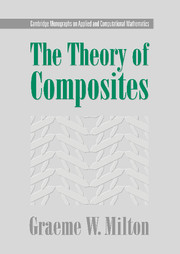Book contents
- Frontmatter
- Contents
- List of figures
- Preface
- 1 Introduction
- 2 Some equations of interest and numerical approaches to solving them
- 3 Duality transformations in two-dimensional media
- 4 Translations and equivalent media
- 5 Some microstructure-independent exact relations
- 6 Exact relations for coupled equations
- 7 Assemblages of spheres, ellipsoids, and other neutral inclusions
- 8 Tricks for generating other exactly solvable microgeometries
- 9 Laminate materials
- 10 Approximations and asymptotic formulas
- 11 Wave propagation in the quasistatic limit
- 12 Reformulating the problem of finding effective tensors
- 13 Variational principles and inequalities
- 14 Series expansions for the fields and effective tensors
- 15 Correlation functions and how they enter series expansions†
- 16 Other perturbation solutions
- 17 The general theory of exact relations and links between effective tensors
- 18 Analytic properties
- 19 Y-tensors
- 20 Y-tensors and effective tensors in electrical circuits†
- 21 Bounds on the properties of composites
- 22 Classical variational principle bounds
- 23 Bounds from the Hashin-Shtrikman variational inequalities
- 24 Bounds using the compensated compactness or translation method
- 25 Choosing the translations and finding microgeometries that attain the bounds†
- 26 Bounds incorporating three-point correlation functions†
- 27 Bounds using the analytic method
- 28 Fractional linear transformations as a tool for generating bounds†
- 29 The field equation recursion method†
- 30 Properties of the G-closure and extremal families of composites
- 31 The bounding of effective moduli as a quasiconvexification problem
- Author index
- Subject index
17 - The general theory of exact relations and links between effective tensors
- Frontmatter
- Contents
- List of figures
- Preface
- 1 Introduction
- 2 Some equations of interest and numerical approaches to solving them
- 3 Duality transformations in two-dimensional media
- 4 Translations and equivalent media
- 5 Some microstructure-independent exact relations
- 6 Exact relations for coupled equations
- 7 Assemblages of spheres, ellipsoids, and other neutral inclusions
- 8 Tricks for generating other exactly solvable microgeometries
- 9 Laminate materials
- 10 Approximations and asymptotic formulas
- 11 Wave propagation in the quasistatic limit
- 12 Reformulating the problem of finding effective tensors
- 13 Variational principles and inequalities
- 14 Series expansions for the fields and effective tensors
- 15 Correlation functions and how they enter series expansions†
- 16 Other perturbation solutions
- 17 The general theory of exact relations and links between effective tensors
- 18 Analytic properties
- 19 Y-tensors
- 20 Y-tensors and effective tensors in electrical circuits†
- 21 Bounds on the properties of composites
- 22 Classical variational principle bounds
- 23 Bounds from the Hashin-Shtrikman variational inequalities
- 24 Bounds using the compensated compactness or translation method
- 25 Choosing the translations and finding microgeometries that attain the bounds†
- 26 Bounds incorporating three-point correlation functions†
- 27 Bounds using the analytic method
- 28 Fractional linear transformations as a tool for generating bounds†
- 29 The field equation recursion method†
- 30 Properties of the G-closure and extremal families of composites
- 31 The bounding of effective moduli as a quasiconvexification problem
- Author index
- Subject index
Summary
So far we have been considering exact relations and links between effective tensors on a case-by-case basis. Grabovsky (1998) recognized that there should be some general theory of exact relations. Utilizing the fact that an exact relation must hold for laminate materials, he derived restrictive constraints on the form that an exact relation can take. This reduced the search for candidate exact relations to an algebraic question that was analyzed by Grabovsky and Sage (1998). Subsequently sufficient conditions were found for an exact relation to hold for all composite microgeometries, and not just laminates or multiple-rank laminates (Grabovsky and Milton 1998a; Grabovsky, Milton, and Sage 2000). A measure of the success of this approach is that it has produced complete lists of all (rotationally invariant) exact relations for three-dimensional thermoelectricity and for three-dimensional thermopiezoelectric composites that include all exact relations for elasticity, thermoelasticity, and piezoelectricity as particular cases (Grabovsky, Milton, and Sage 2000). At present the general theory of exact relations is still not finished. There is an apparent gap between the known necessary conditions and the known sufficient conditions for an exact relation to hold. In addition, the associated algebraic questions have only begun to be investigated.
Links between effective tensors as exact relations: The idea of embedding
Any exact microstructure-independent relation satisfied by an effective tensor L⋆ implies that L⋆ lies on smooth manifold with an empty interior in tensor space.
- Type
- Chapter
- Information
- The Theory of Composites , pp. 355 - 368Publisher: Cambridge University PressPrint publication year: 2002



